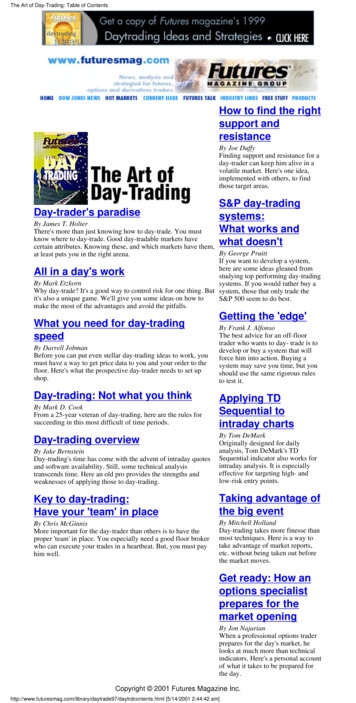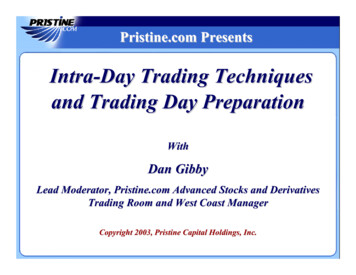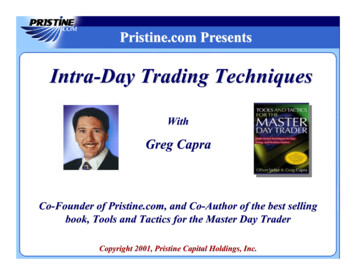
Transcription
The Art of Day-Trading: Table of ContentsHow to find the rightsupport andresistanceBy Joe DuffyFinding support and resistance for aday-trader can keep him alive in avolatile market. Here's one idea,implemented with others, to findthose target areas.Day-trader's paradiseS&P day-tradingsystems:What works andwhat doesn'tBy James T. HolterThere's more than just knowing how to day-trade. You mustknow where to day-trade. Good day-tradable markets havecertain attributes. Knowing these, and which markets have them,By George Pruittat least puts you in the right arena.If you want to develop a system,here are some ideas gleaned fromAll in a day's workstudying top performing day-tradingBy Mark Etzkornsystems. If you would rather buy aWhy day-trade? It's a good way to control risk for one thing. But system, those that only trade theit's also a unique game. We'll give you some ideas on how toS&P 500 seem to do best.make the most of the advantages and avoid the pitfalls.What you need for day-tradingspeedBy Darrell JobmanBefore you can put even stellar day-trading ideas to work, youmust have a way to get price data to you and your order to thefloor. Here's what the prospective day-trader needs to set upshop.Day-trading: Not what you thinkBy Mark D. CookFrom a 25-year veteran of day-trading, here are the rules forsucceeding in this most difficult of time periods.Getting the 'edge'By Frank J. AlfonsoThe best advice for an off-floortrader who wants to day- trade is todevelop or buy a system that willforce him into action. Buying asystem may save you time, but youshould use the same rigorous rulesto test it.Applying TDSequential tointraday chartsBy Jake BernsteinDay-trading's time has come with the advent of intraday quotesand software availability. Still, some technical analysistranscends time. Here an old pro provides the strengths andweaknesses of applying those to day-trading.By Tom DeMarkOriginally designed for dailyanalysis, Tom DeMark's TDSequential indicator also works forintraday analysis. It is especiallyeffective for targeting high- andlow-risk entry points.Key to day-trading:Have your 'team' in placeTaking advantage ofthe big eventBy Chris McGinnisMore important for the day-trader than others is to have theproper 'team' in place. You especially need a good floor brokerwho can execute your trades in a heartbeat. But, you must payhim well.By Mitchell HollandDay-trading takes more finesse thanmost techniques. Here is a way totake advantage of market reports,etc. without being taken out beforethe market moves.Day-trading overviewGet ready: How anoptions specialistprepares for themarket openingBy Jon NajarianWhen a professional options traderprepares for the day's market, helooks at much more than technicalindicators. Here's a personal accountof what it takes to be prepared forthe day.Copyright 2001 Futures Magazine aytrdcontents.html [5/14/2001 2:44:42 am]
The Art of Day-Trading: Table of ContentsSpecial Online Offer:Day-Trading Ideas & StrategiesIf you found some profitible ideas in the online special issue The Art ofDay-Trading, you're sure to enjoy the even more comprehensive Day-TradingIdeas & Strategies.This special issue is now available as an electronic, fully viewable *.pdf fileexclusively to online readers of The Art of Day-Trading at the special price of 19.95 (regular price: 24.95). Using Adobe's free Acrobat Reader (downloadfrom Adobe here), you can read, navigate and study the valuable strategies andinformation in this popular special issue right from your own computer!Here are just a few of the topics in Day-Trading Ideas & Strategies:Successfully Scalping the S&P 500 by Linda Raschke.The Devil's in the Data by Bob Buran.Day-Trader's Doom: Whipsaws & How to Avoid Them by CynthiaKase.Day-Trading Software Shootout by James T. Holter.Plus much more!To order this electronic special issue for speedy e-mail delivery, just call ouroperators with your credit card information handy at (800) 972-9316, ext. 255.Copyright 2001 Futures Magazine ffer/daytradeoffer.html [5/14/2001 2:44:44 am]
How to find the right support and resistanceHow to find the rightsupport and resistanceMy personal preference for day-trading and short-term trading is tobuy dips and sell rallies.Two components are needed to make this strategy work. First, youhave to be trading in the direction that gives you the best chance ofsuccess. Second, you have to be able to identify potential support orresistance for that trading day. I'll discuss one technique from eachof these two components that make up my day-trading approach.The first step is to determine which way the market is likely to go today -- in other words,is the trend up, down or sideways?One method to determine the market trend involves a couple of old standby technicalindicators that are available on virtually any charting software: the Moving AverageConvergence Divergence (MACD) and the stochastic indicators. These oldies but goodiesreally can be useful if used in the proper combination.Look at both the MACD and the Slow Stochastic on adaily chart to determine in which direction you want totrade the next day. For the MACD, I use a little longertime value for my inputs then the standard -- say, around a10-30-10 exponential moving average combination. I alsouse a slow stochastic indicator with an input value ofsomewhere around 20 days.Both of these indicators should be displayed together under the price data. Look forsituations when both the MACD indicator and the stochastic indicator are on the same sideof the signal line.If both are above their respective signal lines, then trade the buy side. If both are belowtheir respective signal lines, trade the sell side. Quite often you'll find the MACD and thestochastic indicators are on opposite sides of their respective signal lines. In theseinstances, avoid the market.The accompanying charts show this simple combination eliminates a lot of noise from themarket and identifies those times when the market has the best chance to make a trendmove. Throw these indicators up on any chart together,and you will see this combination works infinitely betterthan either indicator alone.Once you've determined the direction to trade, the nextstep is to find support if you want to buy or resistance ifyou want to sell. There are several ways to do this, andmy usual strategy is to employ several methodologies tocome up with a confluence or a "keypoint" high-probability trading zone.Here is one methodology that is being described for the first time. There is no neat namefor this indicator, so I'll just call it the 3x5ATR. To construct it:1. Add up the true ranges for the last five days and divide by five. This is the 5ATR.2. Calculate a three-day simple moving average of the highs and a three-day simplemoving average of the lows.3. To calculate the 3x5ATR for potential resistance, add the 5ATR to the three-day movingaverage of the lows. To calculate the 3x5ATR for support, subtract the 5ATR from thethree-day average of the highs.An important point is that this is not a total day-trading strategy. Look to combine othertechniques that identify potential support and resistance points. A good rule to live by is tolook for a confluence of support or resistance by integrating analysis techniques andintegrating time frames.Joe Duffy is a former trading contest champion and author of three books and videos onhis trading techniques. A private trader, he contributes research and analysis to the"Professional Traders Advisory," a daily market letter specializing in stock indexes, bondsand selected special situations in the futures markets. E-mail: Joeduffy@interlog.com.Back to contents pageCopyright 2000 Futures Magazine ay7.html [5/14/2001 2:44:48 am]
March S&P 500 index futures/March T-bond futuresThe alignment of the MACD and stochastic indicators together shows you the market trend.When both indicators are below the signal line, as they were in early December for both the S&P500 Index and T-bonds, you should be a seller; if both are above the signal line, as they were inearly February, you should be a de97/daypic7.html [5/14/2001 2:44:53 am]
Support and resistence linesBy combining the five-day average true range with simple three-day moving averages of the highsand lows, you can create the 3x5ATR indicator to find support and resistance areas that can beused in a day-trading strategy of buying on dips and selling on rallies. The S&P charts above andthe above, left T-bond chart show examples of support lines using the 3x5ATR; the above, rightT-bond chart illustrates a resistance line using the ade97/daypic8.html [5/14/2001 2:45:02 am]
S&P day-trading systems:What works and what doesn'tS&P day-tradingsystems:What works andwhat doesn'tOf all the day-trading systems I've tested over the years, 90% ofthem trade the S&P 500. This is the market of choice for mostday-traders because it affords enough potential to make it aworthwhile venture (see "Volatility heaven," below). By definition,day-trading means you exit at the end of the day, so your profitsmust at least cover your commissions and slippage.Although a key difference with the S&P systems I've tested is theirapproach to entering the market -- they have ranged from basic breakout systems tosystems based on the phases of the moon -- the exit signals usually fall into fourcategories: protective stop, profit target, trailing stop and, of course, market on close.Many of the systems use a combination of these exits.Because the exit technique is as much or more important than the entry in day-trading theS&P 500, I'll demonstrate that different types of exits work with various types of systems.Over the past eight years I've often been asked which exit technique is the best. Theanswer is it depends on the system; there is no black or white answer. However, throughresearch, I've found the success of these exit techniques usually depends upon thefrequency of trades a system generates: More frequent trading systems need tighter exitswhereas less frequent trading systems need looser exits.Volatility heavenTo demonstrate the success or failure of protective stops,profit targets and trailing stops, I've created two systemsand tested them over the past 11 years.These systems use basically the same entry technique,except one trades about five times as much as the other.Buy and sell signals are calculated by adding/subtractinga certain percentage of the 10-day-average range to yesterday's close. In addition, today'srange must be less than the 10-day-average range before a buy/sell signal can be placed.The only difference in the two systems is the percentage used to calculate the buy/sellsignals. System A uses 50% and System B uses 120%. These percentages were determinedby the frequency of trades I was trying to attain.The systems were tested using five-minute bar data and deducting 100 commission/slippage per trade. I ran three tests on each system, optimizing different dollar levels foreach exit technique. None of the test results of these two systems includes any trades thattook place during October 1987 and October 1989. Due to extremely high marketvolatility, these two time periods can skew performance data.Protective stop If a system has a high frequency of trades, tight stops usually work best.My definition of a tight stop is anywhere between 300 and 750. Systems that tradefrequently are trying to make money almost on a daily basis. If the system takes a smallloss, then there is always tomorrow; why take a major loss when you know a tradeprobably will be generated tomorrow?System A (see "Protective stop comparison," right) showsthe performance of the system using several differentprotective stop levels. Notice that too tight of a stop alsodegrades performance. A protective stop, at the rightlevel, can turn a losing system into a winner. A systemthat trades less frequently usually will need a larger stop.Unlike faster approaches, these systems are in the marketfor considerably less time and therefore need to makemore money per trade. A larger stop prevents a prematureloss due to market volatility. System B shows theperformance of the slower system using differentprotective stop levels. As you can see, a larger stop isneeded in this case.Profit targets Pure profit targets generally don't work. Agood portion of the profit that is generated by an S&Pday-trading system comes from those days when the S&Ptakes off and keeps going in the same direction. If youlimit these potential high-profit days, then you limit theoverall profit of your system. System A (see "Variation inprofit targets," right) shows terrible performance usingtighter profit targets. Due to its frequency of trades, therisk reward ratio is out of whack. Are you willing to risktrading the S&P 500 on a daily basis in hopes of a 250win? System B also shows degraded performance byusing tight profit targets. This system trades soinfrequently, it almost has to hit a home run on every trade.Trailing stops A trailing stop is a combination of a protective stop and profit target. Thistype of stop gives the market room to breath but at the same time tries to lock in profit. Inthis analysis, I trailed the high/low of the day by x-amount after a trade was initiated. Thetrailing stop did not help System A (see "Hitting the trailing stops," below, left) as much asthe fixed protective stop. The profit target aspect of the trailing stop was too limiting onthe big profit days. Nonetheless, the trailing stop turned a losing system into a winner.System B showed a slight increase in performance at the high end of the trailing stop. Thisre-emphasizes the need for a large protective stop and large profit target.All tests were done using static stop amounts. In today'smarket, 500 is totally different than it was in 1986. Ihave found, in almost all cases, that self-adjustingparameters create a much more robust system. Analternative to static dollar stops, would be to usevolatility-based, self-adjusting stops. For example, insteadof 500 fixed stop, use 10% of the past 10-day averagerange. This market-defined stop would change withmarket conditions.There is no black or white answer to which type of stop isthe best to use in a day-trading system. The results shownare consistent with my research; however, it is not a guarantee that all systems will followsuit. A large portion of S&P day-trading systems use a combination of these exits. I haveseen systems that will use a protective stop early in the day and a trailing stop later in theafternoon. Whichever stop you pick, it should be based on thorough research. The longertime frame over which you can test, the more robust your parameter selection will be.We are fortunate to have so much intraday data at our disposal, yet at the same time thedata is somewhat skewed. We basically have been in a bull market ever since the S&P 500futures contract has been traded. Close to 100% of the symmetrical S&P day-tradingsystems (buy/sell signals are mirror images of each other) have shown much more profiton the long side. With this fact, the question "Why short the S&P?" always arises. And ofcourse the answer always is: "Who knows when a major retracement or bear market isgoing to occur." The second question is: "Is it okay for a system to have a bullish bias?" Inother words, should a system try to buy more often than it sells? Again, there really is nocorrect answer. There won't be good answer until we have a good sample of bear marketdata on which to test.Let's look at some before and after performance numberson System A and System B (see "Before and after," right).System A, without an exit, was a big loser. However, witha simple 500 protective stop, the system turns into awinner. System B was a mediocre winner without anytype of stop, but with a 1,250 protective stop and a 3,000 profit target, the system's overall drawdowndecreased by about 60%. Notice the profit/loss that camefrom the long and short positions.The changes we made look great, but I must warn youabout curve fitting, which is when you historically backtest to derive a parameter. Don't fool yourself intothinking you've found the holy grail, when in fact you hadyour 166 MHz computer run two weeks optimizing sixparameters. You don't want history to have to repeat itselfexactly for your system to make money. Never test the S&P with less than 100commission/slippage; in fact real-time analysis has shown slippage to be well over 100. Asystem tested at 50 commission/slippage looks totally different than one tested at 100.The lack-luster performance of System A and System Bmay lead you to believe that day-trading the S&P 500 isnot your cup of tea. I derived these systems fordemonstration purposes only and didn't strive to makethem profitable. Futures Truth monitors about 20 S&Pday-trading systems, and about nine of them have shown a profit since they were releasedto the public (see "Top S&P day-trading systems," above).The best two systems, R-Breaker and R-Levels by Richard Saidenberg, have shownreal-time performance similar to hypothetical performance (see "Top performers," below,left). These systems were released to the public in July 1993. The equity curve after thisdate looks as good as the equity curve before. These systems have been successful becauseof Saidenberg's countertrend approach to entry and his exit mechanisms. He incorporates acombination of the exit techniques discussed here. His two systems took advantage of theheightened volatility in 1996. In the 1980s, any simple breakout approach seemed to workin the S&P. But during the 1990s, other types of entry and exit techniques have excelled.Because no system wins all thetime, exit techniques provide aform of insurance when thesystem is wrong. As with alltrading, risk should be measuredand taken into considerationbefore placing an order. Don'tarbitrarily place some type of exit technique without knowing the mentality of the system.I've been told that 40% of research should be spent on the system and 60% should be spenton money management. In day-trading, your exit is your money management.George Pruitt is director of research of the independent system testing firm, Futures TruthInc., in Hendersonville, N.C., which publishes a monthly review of the systems it tests. Atop-10 system performance list can be found in Futures on a bi-monthly basis.Back to contents pageCopyright 2000 Futures Magazine ay8.html [5/14/2001 2:45:09 am]
Volatility de97/daypic10.html [5/14/2001 2:45:13 am]
Protective stop ytrade97/daypic11.html [5/14/2001 2:45:17 am]
Variation in profit ade97/daypic12.html [5/14/2001 2:45:20 am]
Hitting the trailing e97/daypic13.html [5/14/2001 2:45:24 am]
Before and e97/daypic14.html [5/14/2001 2:45:26 am]
Top S&P day-trading ade97/daypic9.html [5/14/2001 2:45:27 am]
Top ytrade97/daypic15.html [5/14/2001 2:45:31 am]
Getting the 'edge'Getting the 'edge'It's no secret most day-trading profits are made by floor traders.They not only have the advantages of low commissions and ease ofexecution, but they have the "edge" or the ability to buy at the bidprice and sell at the ask price. Although day-trading off the floor isa completely different game, traders also must have some sort ofadvantage that will give them a trading edge.Certainly live, tick-by-tick quoting equipment is necessary, alongwith charting and technical analysis software. Most noviceday-traders watch prices, analyze various intraday charts andindicators, thinking they can assimilate this flow of information andmake profitable trades. They often hope for some sort of "sixthsense" to give them an advantage. Unfortunately, the market usually demonstrates it hasmore of a sixth sense and soon separates the trader from his money.Something concrete is needed to give a trader the confidence and commitment to "pull thetrigger." There are so many examples in books and magazine articles isolating some guru'sfavorite chart formation or technical indicator that shows where to buy or sell. New tradersfollow this advice based on "trust" that the author or guru knows from experience what heis talking about. But doesn't it make sense to ask, "How many times in the past when thisindicator signaled a buy, did the price actually go up?" Or, "If we use a close 200 stop assuggested, how many times did we get stopped out for a loss, only to have the market turnaround and produce what would have been a profitable trade?" Or, "If we buy a breakoutof the previous day's high, how many ticks in profits can we expect, given various marketconditions?"Knowing the answers to such questions will give you an "edge" to win at day-trading.With all the computing power and historical data available today at relatively inexpensiveprices, you have no excuse to day-trade without hard statistical facts.Results of historical testing on technical indicators, chart formations or price patterns canbe combined with a "signal generator" to form a trading system. Actual buy and sellsignals are generated throughout the day based on trading models developed with historicaltesting. If you have a limited degree of computer knowledge, use TradeStation orSuperCharts RT by Omega Research or MetaStock RT by Equis International to test amyriad of day-trading strategies and create trading systems. Expert computer users candevelop more advanced strategies using Microsoft Visual Basic or C .To develop a day-trading system, you must obtain historical data and one of the "toolbox"software programs that can test trading ideas.There are five main rules to follow when developing a day-trading system:1.Use long test periods Novice traders often test a strategy back over several contracts, oreven several years, and think they have a tradable method. Unfortunately, day-tradingbased on this limited testing will end in disaster. Any trading method must be tested for aminimum of five years and preferably 10 years or longer. Then, the reality of moredown-to-earth performance statistics appear.2.Robust variables When testing, or incrementing variables for a system, it is importantthat wide ranges of values generate favorable results. If just a few variable incrementsproduce acceptable results, the trading rule is fragile. Future results will be poor.3.Limited number of rules Any trading method could be 100% accurate and displayimpressive profits if an unlimited number of rules were used, however the method willalmost certainly fail in real-time trading with new data. Keep the number of rules orconditions a system uses to less than five or six for a 10-year period or slightly higher ifthe number of trades or occurrences is high.4.Real-time or out-of-sample testing After historical tests have been completed overreasonably long time periods, and variable values have been selected, the trading methodshould then be tested over new or "real-time" data. This "out-of-sample" test is usuallyover current data, using a shorter period of one to two years. The results will give a goodidea of system performance, just as if the trader were using it in the market during this timeperiod. Out-of-sample tests on periods prior to the historical testing period also areacceptable but not as useful as tests over more recent data.5.Walk-forward testing Most testing programs do not have this advanced feature, whichis really an automated way of generating a whole series of out-of-sample tests. Thisapproach increments or optimizes system variables over a moderate time period, such astwo years. The variable values that produce the best results over this "learning" period arethen used on the next quarter (three months), which is new or "real-time" data. The resultsshould be profitable. Then, the first quarter of the learning period is eliminated, and thenext quarter in the database is added to the multi-year learning period. Variables again areincremented and the best ones are selected for use in the next out-of-sample quarter.Testing continues like this all the way through the database. The net performance of allout-of-sample tests is summarized. Overall, the results should be profitable to consider thesystem valid for trading with real funds. If the system doesn't hold up to this testingmethod, it won't make money in the future.period!Purchasing a system After new traders discover developing their own system is not thateasy, they may consider purchasing a trading method from a system developer. But how doyou decide which system to purchase?First, all the rules given previously for developing your own system should have been usedby the vendor. Ask him how the method was developed. Were long test periods used?Does the system have robust variables? Are only a limited number of rules or conditionsused? Was walk-forward-testing employed, etc.?Then, once you receive the program, you must be able to verify the vendor's marketingmaterial with the software itself. Don't just buy a "signal-generator." The system youpurchase should duplicate the results advertised. You should be able to run historical testsover data and see for yourself the simulated performance of the system.Don't just rely on the vendor's brochure or performance numbers. Go back and run longhistorical tests over the data. Increment the variables and check for robustness. Change thesystem variables, and do some out-of-sample tests. Then, if the method holds up to the fiverules for developing a system, it can be relied upon for real trading.Capital Next you need to determine the right amount of capital to use. This is where theresults of historical testing are helpful.The account size should be large enough to cover the largest maximum drawdown (largesthistorical account equity decrease) of the system, plus margin amounts. Again, this iswhere the importance of using long test periods shows up. If the maximum drawdown forthe last two years was only 1,800, and you don't realize a big drawdown of 5,000occurred six years ago, you are not aware of the potential risks of trading the method andwill not allocate enough trading capital.Plan for drawdowns. Assume the maximum drawdown will start on the day you starttrading the program. Also, be aware that future drawdowns can exceed previous historicalmaximum drawdowns.Knowing the maximum drawdown also can be used to improve day-trading performance -one technique is to wait for a good-sized drawdown to occur on paper before starting totrade the system.Another technique is to keep an eye on systems and variable sets that are not performingwell and are in a drawdown. Start trading them with a small profit objective. If the tradesare profitable immediately, take the profits and stand aside, and wait for anotherdrawdown. If the trades go against you, continue trading the system until the profitobjectives are reached. However, you need to have the additional capital available to staywith the system until it begins to recover from the drawdown.You also must have a high level of confidence in asystem to start trading when it is in a drawdown.Systems tend to run in cycles. Most traders will hopon and start trading a system after it has had a veryprofitable period, only to catch the next downcycle. Then, when it is in a losing period, they starttinkering with it, trying to second guess the system, instead of just sticking with it. Oftenthey end up missing the next big profitable cycle. Following the five rules for historicaltesting will give you the confidence to start trading a system when it is in a drawdown.Many traders also try to add additional filters or rules during drawdowns. However, thisbreaks one of the primary rules of developing a system. Adding additional conditions orrules just makes the method less reliable in the future. Accept the drawdown as part of anecessary risk of trading. Let the system run its course and stick with it. Execute yourplan.that's your "edge!"Frank J. Alfonso is president of MicroStar Research & Trading Inc. in Sarasota, Fla. Hehas developed trading systems for 20 years, is a former CPA, floor trader and member ofthe Chicago Board of Trade.Back to contents pageCopyright 2000 Futures Magazine ay9.html [5/14/2001 2:45:36 am]
Developing a day-trading systemThe below test demonstrates several of the important rules required to develop a profitable day-tradingsystem. The test covers a trading system for T-bond futures from 1983 through February 1997 (long testperiod). There are eight variables, A through H (limited number of rules), which is reasonable given thelong test period and the more than 3,500 trades. Variable A is incremented from 100 to 200, with the othervariables held constant. System performance, measured by net profit and loss and maximum drawdown,demonstrates robust variables, as large changes in Variable A still produce very good results.Incrementing the other variables also should produce similar rade97/daypic16.html [5/14/2001 2:45:40 am]
Applying TD Sequential to intraday chartsApplying TD Sequential tointraday chartsWhen I entered the investment business more than 25 years ago,volume on the New York Stock Exchange was approximately 6million shares a day. Stock quotations appeared on a ticker tape,and futures quote
Day-trading: Not what you think By Mark D. Cook From a 25-year veteran of day-trading, here are the rules for succeeding in this most difficult of time periods. Day-trading overview By Jake Bernstein Day-trading's time has come with the advent of intraday quotes and software availability. Still, some technical analysis transcends time.


![Welcome [dashdiet.me]](/img/17/30-day-weight-loss-journal.jpg)







